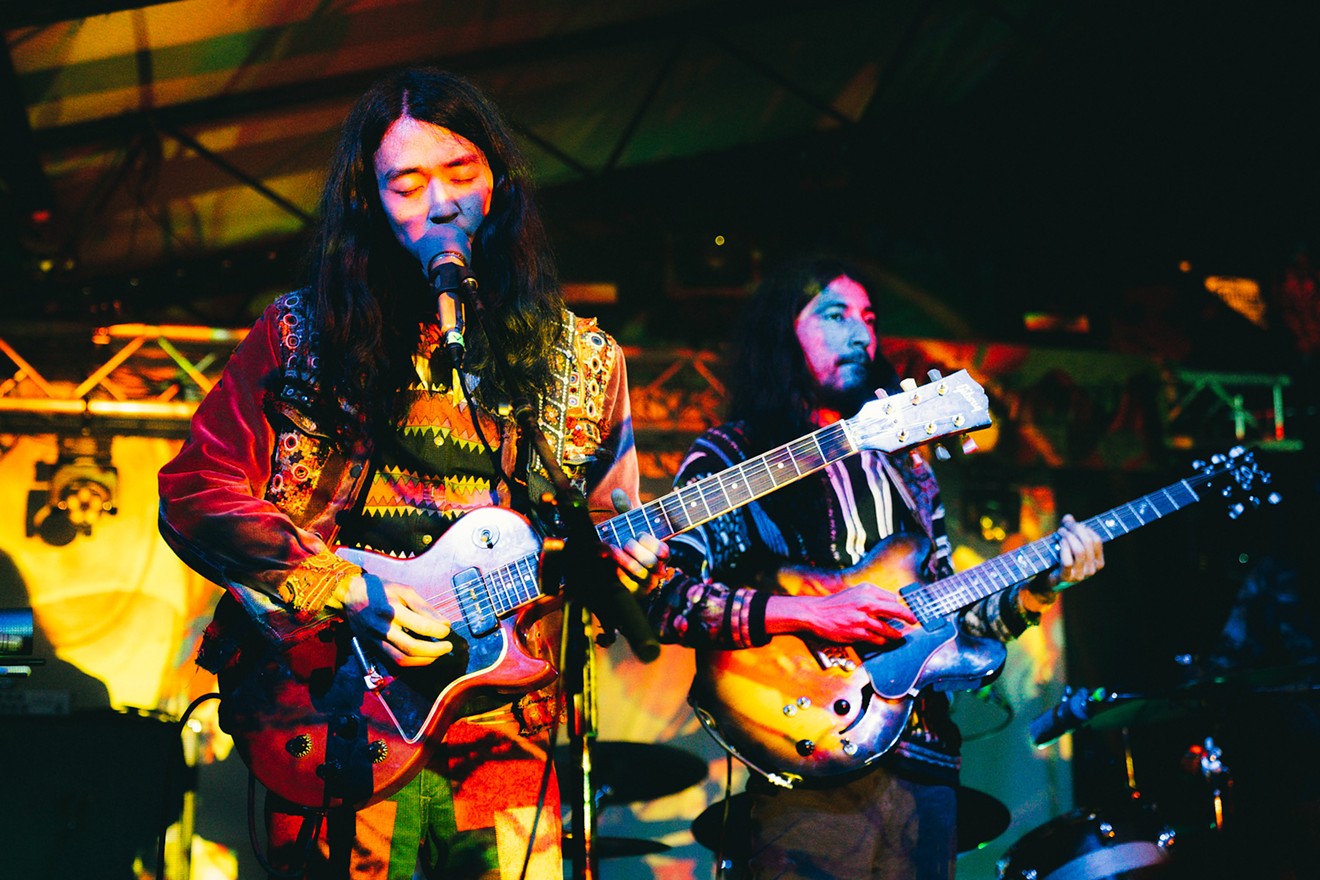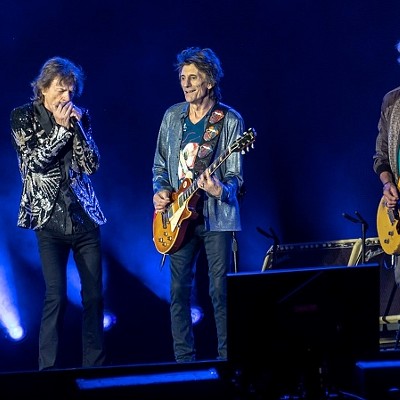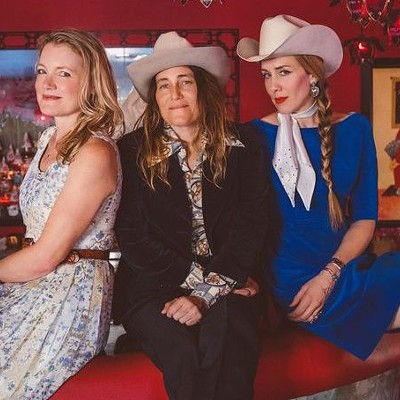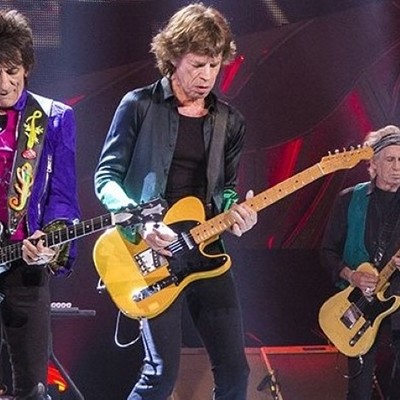Aside from modern pop’s incorporation (*cough* appropriation) of the genre’s aesthetic, the national craze around this music and its culture is clearly not as prevalent as it once was, when thousands of young Americans blew off their middle-class expectations for the Learyology of “dropping out and tuning in.” Since the start of the decade, however, a more subtle independent scene has been brewing thanks to forward-thinking artists like The Black Angels, Ripley Johnson, John Dwyer, Ty Segall, and Australia’s King Gizzard & the Lizard Wizard (along with a collection of select labels like San Francisco’s Castle Face).
With the public eye no longer infatuated with these artists' every next move (and with major labels no longer siphoning whatever they can off of them), this modern day psych-rock community is one built on prolificity, a live show first demeanor, and a D.I.Y. philosophy—oftentimes self-releasing their work, or simply creating a label of their own. In turn, these artists and their respective fan bases have become an international and self-sufficient anomaly of the music industry.
No band better illustrates the power of this ecosystem than Kikagaku Moyo. Cutting their teeth busking on the streets of Tokyo in 2012, Kikagaku Moyo (Japanese for “geometric patterns”) quickly established a free-flowing brand of rock music that incorporates everything from avante-garde folk to Indian raga to prog-heavy Krautrock—always certain to maintain a psychedelic quality to each component. By the time of 2016’s House in Tall Grass (released under their own label, Guruguru Brain), the band had become international darlings of the psych community. Yet, true to the psych-rock ethos, it’s Kikagaku’s live reputation that truly propelled them to that point, as the band’s relentless touring schedule (spanning across nearly every continent) has molded the five member’s live set into an immersive experience that’s certain to floor its audience night after night.
This is all to say whenever the band announced that its first official live album would be released January 15, fans and critics alike were thrilled to say the least. Whenever we discovered this live album would be from their two appearances at Austin’s world-renowned Levitation Fest (formerly Austin Psych Fest), Texan fans had even more to look forward to.

Kikagaku Moyo at The Mohawk, their second of two performances at Levitation 2019.
Photo by Connor Fields
“When we played the first time, it was our first time touring the U.S., so we didn’t know anything about it. It was just a crazy experience for us,” says drummer/vocalist Go Kurosawa. “We started by busking on the streets, so we were always used to playing with many different people, where friends would join and leave. So by the time we got to Austin, that was when we were building confidence as a band...starting to build an identity with just five people. It was the first time we ever played in front of a big audience, so we didn’t know anything about monitors or this technical stuff. We didn’t even know what to do at sound check [laughs]. I didn’t even own drums at the time!”
Yet, in listening through Side A alone, one could hardly guess this is a band in its early formation. Aside from the album opener, “Streets of Calcutta”—the most garage-driven and crude the band gets—the rest of Side A displays a rarified level of instrumentation and group synergy. Take “Smoke and Mirrors” for instance. From the band’s 2014 debut, Forest of Lost Children, the live offering takes the listener on a boundless journey of sound, dramatically shifting from the mellow sitar-laden verses, to explosive fast-paced breaks of distortion and phase-shifting. As a listener, you can feel the band’s controlled hysteria melting into the South Texas summer heat —something Kurosawa himself resonates with. “The first time hearing the recording, it gave me chills. I can feel the moment and the sweat. I also love being able to hear the audience.”

With the skilled engineering of Craig Lawrence and Alexander Dubois (those who recorded both performances), audience reactions add an important element to Live at Levitation, giving it that bootleg feel that psych fans (like Go Kurosawa) crave.
Photo by Connor Fields
“I don’t really like live records unless it’s Deep Purple, or something kind of bootleg like the Velvet Underground—where you can hear people talking,” explains Kurosawa. “Whenever bands release live records officially, they always try to make it sound as good as a studio record, which I’m not a fan of. So we didn’t really ever think about doing it. But when Levitation gave us the idea, we wanted to do it because that festival is so special.”
“When we first heard about Austin Psych Fest, we were like “oh we gotta play that” [laughs]. This is not like other cities and not like other festivals. When we played there [in 2014], I felt like even the people working there really loved to be working...everybody is part of the thing, and everybody is contributing something. It was almost shocking how it was run, and I think that made us feel like it’s a special thing.” Therefore, whenever it came to the decision of releasing their first live album—something the band knew its fans were craving—they “couldn’t do a normal New York show or San Francisco show. It’s gotta be Austin and that festival.”
With six years of relentless touring under their belts, two more full-length’s worth of material to explore, and an added sense of international acclaim to their name, Kikagaku Moyo’s return to Levitation in 2019 marked quite a contrast from their first appearance. Yet, for a band as interminably-dedicated to the road as Kikagaku, the differences weren’t quite as linear. “Even though it was five years, it didn’t feel that way,” explains Kurosawa. “We felt like we didn’t really change, because it’s always been the same people touring, and so only the city and scenery changes...so it’s hard to notice any changes because we are spending everyday together. But when I look back to 2014, it’s like “oh we look so young” [laughs]. It’s more raw...it’s kind of like you’re a baby and you don’t know that everyday changes, but when you look at a picture a month ago, the baby has grown a lot.”

With the tone of a man possessed, guitarist Tomo Katsurada leads the band through Live at Levitation's many explosive moments.
Photo by Connor Fields
This is not only a tenured band that know each other's musical tendencies well, but more importantly a band that knows exactly how these tendencies will resonate with its crowd. With many of their songs suddenly altering tempos and volume (like Side B’s “Gatherings”), the band heavily relies on improvisation to feel out where each song should go—something that can either make for a monumental moment or absolutely crater any built-up momentum. “We expand the songs and change the set list everyday...we make it free. That takes a big role for us to enjoy touring so that every show is different. So it’s kind of challenging, and sometimes a little bit risky, because sometimes we play a jam section that doesn’t go anywhere and completely falls apart. The audience can sometimes tell, and sometimes not...I like that part of improvisation.”
Being at both of Kikagaku's 2019 festival performances, I was fortunate enough to experience the band’s free-improv philosophy first hand, having attested to its impact on the festival audience ever since. With Live at Levitation, I now have documentation, as the experimental sections of the set (like album closer “Nazo Nazo”) take on a whole new life from the album version, veering into the jam world with a exploratory sitar/guitar interaction that slowly brings the audience back down to earth—a payoff that matches any heavy sections of the performance.
With so many beacons of the independent music community having fallen victim to COVID-19’s wrath (including Barracuda), self-sustainable artists like Kikagaku Moyo, and festivals like Levitation have never been more crucial. This is true not only for the burgeoning psychedelic community, but really independent artists everywhere—as independent-averse developments like streaming and corporate festival culture were already weeding out the few who still support making high-art both financially and creatively feasible.
Given this, Live At Levitation represents a time capsule of sorts, defining a time that we’ve been highly in need of as of late—when music fans would cram (safely) into a sweat-filled venue to see a rare international artist, when those international artists wouldn’t hesitate to fly to Texas to play an obscure festival for reasons other than a high guarantee, and when the people throwing that festival were doing so with the art community in mind before all else.






